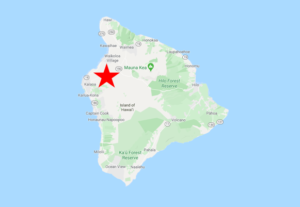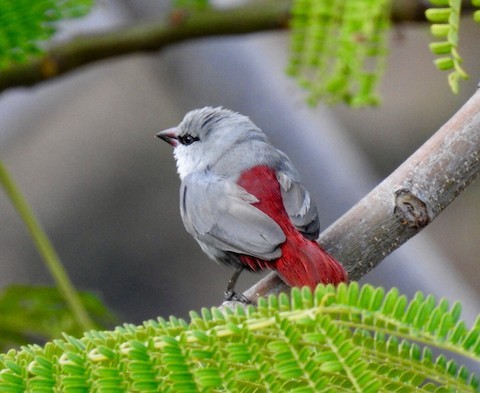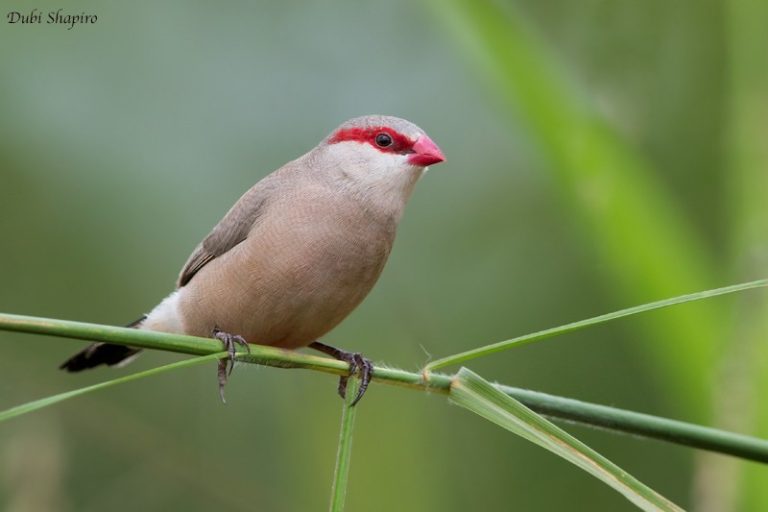Pu’u Anahulu, Big Island, Hawaii

In the early and mid-1900s the ranchland around Pu’u Anahulu was Ground Zero for a steady stream of intentional introductions of non-native birds, especially gamebirds and finches, including a few that still persist. Most of the species introduced did not become established, and some flourished briefly then disappeared. Into the early 2000s, Pu’u Anahulu had eight waxbill species: Lavender, Common, and Black-rumped, Red-cheeked Cordonbleu, Red Avadavat, African Silverbill, Scaly-breasted Munia, and Java Sparrow. At least six of them remain, along with several other exotics, and the area still supports a few endemics, including Hawaiian Goose, Hawaiian Coot, “Hawaiian Stilt”, Hawaiian Hawk, and Common Amakihi.
Orientation
Directions
Pu’u Anahulu is in the northwestern interior of the Big Island, about half an hour’s drive (~20 miles) northeast of Kailua-Kona, and an hour and 10 minutes (~60 miles) west of Hilo.
From Kona International Airport. Take Route 19 south for 1.2 miles, turn east on Kaiminani Drive, and go 3.6 miles to the T-junction with the Mamalahoa Highway (also part of the Hawaii Belt Road and Route 190). Turn north on Mamalahoa, go 13 miles to Pu’u Anahulu.
From Hilo International Airport. Turn left (south) onto Kanoelehua Avenue (which is also the local segment of the Hawaii Belt Road), go one mile, turn right (west) onto Puainako Street (Route 2000). Remain on Puainako through its brief dogleg intersection with Komohana Street at the University of Hawaii – Hilo Campus, then continue west on Puainako which departs Hilo and becomes Saddle Road.
Approximately 40 miles from the university, turn left onto the Daniel K. Inouye Highway. After 9.8 miles, this road ends at a junction with the Mamalahoa Highway. Turn left and go 6 miles to Pu’u Anahulu.
Birdfinding
Pu’u Anahulu is the name of a small town, often applied to the area as a whole. The main points of interest are the Pu’u Wa’awa’a Forest Reserve which is south of the town and the Makani Golf Club, which is on the north side of the highway across from the town.
Pu’u Wa’awa’a. The Pu’u Wa’awa’a Forest Reserve can be explored via the trail system which originates where the Mamalahoa Highway turns sharply at the base of the hillside. The most direct hike from the trailhead to the top of the Pu’u Wa’awa’a cinder cone is four miles, following the Halapepe Trail to Vulcanite Road then the Cinder Cone Trail. A slightly longer alternative is to take the Ōhiʻa Trail and Miki’s Road, thus omitting most of Vulcanite Road.

Red Avadavat is fairly common around Pu’u Anahulu. © Souvik Roychoudhury
This hike, or a shorter one, is likely to produce Wild Turkey, Black and Erckel’s Francolins, Warbling White-eye, Eurasian Skylark, Common Amakihi, Yellow-fronted Canary, and Saffron Finch. Somewhat less common, but possible, species include Kalij Pheasant and Hawaiian Hawk.

The Pu’u Wa’awa’a area was formerly famous for a wide array of introduced birds, most of which have not been seen in Hawaii since the mid- to late 1900s. Waxbills were especially well-represented, including two specialties: Red-cheeked Cordonbleu and Black-rumped Waxbill. The former persisted until at least 2005-06 and the latter into the 2010s—and either one might still persist undetected. The only waxbill that remains common in the forest reserve is African Silverbill, but five others were still reported regularly into the 2020s: Lavender and Common Waxbills, Red Avadavat, Scaly-breasted Munia, and Java Sparrow.
Makani Golf Club. The elegantly landscaped, verdant golf course has a few resident Hawaiian Geese and was long known as the most reliable spot to find them—before they became widely common in the 1980s and ‘90s. It is private property so visitors who drop by do not have a right to roam its grounds, but it has traditionally welcomed or at least tolerated the mild intrusions of a few passing birdwatchers. Be sure to inquire at the entrance (or visit Makani Golf Club) for the current policy toward non-golfing visitors.
Other species usually or often present include: California Quail, Wild Turkey, Black, Gray, and Erckel’s Francolins, Common and Kalij Pheasants, Hawaiian Coot, Pacific Golden-Plover (August-April), “Hawaiian Stilt”, Black-crowned Night-Heron, Warbling White-eye, Eurasian Skylark, Yellow-fronted Canary, Northern and Yellow-billed Cardinals, and Saffron Finch.

Lavender Waxbill was one of many exotic finch species released on the Pu’u Wa’awa’a Ranch. © Ron Pozzi
The waxbills found at Pu’u Wa’awa’a also occur on the golf course, where most of them are somewhat more common or observable. The golf course is notably reliable for Red Avadavat and Java Sparrow.
Pu’u Lani. The lush housing development across the highway from Makani Golf Club was formerly known for most of the same species—especially francolins, pheasants, and waxbills—but it became a gated community, so access is limited to residents and their guests.
Services
Accommodations
The Kona region has no shortage of accommodations. There are several hotels in Kailua-Kona itself and larger resorts north along the coast to Waikoloa. Interior Kona subdivisions en route to Pu’u Anahulu, such as Kaloko Mauka, also have various B&Bs and other alternatives.
More centrally located for access to Pu’u Anahulu, Pu’u La’au, Saddle Road, and both coasts, are a handful of hotels in the town of Waimea, about 20 miles northeast of Pu’u Anahulu.
Notes
Links

